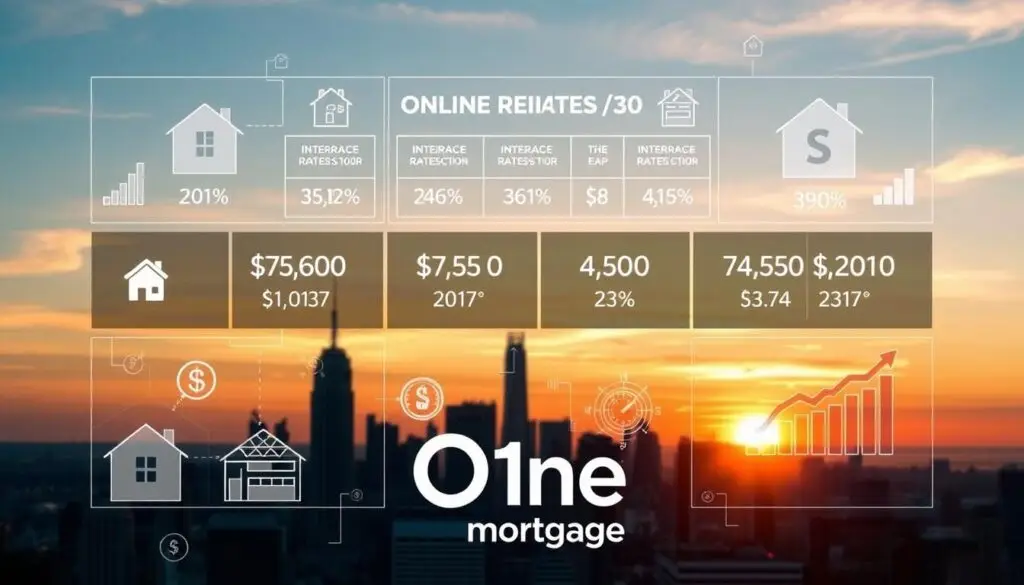Securing a home is a significant milestone, and with the right home loans, achieving your real estate goals is within reach. At present, the national average 30-year fixed mortgage Annual Percentage Rate (APR) stands at 6.48%, closely shadowed by the fixed refinancing rate of 6.49%. Our mission is to guide you through the dynamic landscape of mortgage options, ensuring you find competitive rates that align with your personal housing aspirations.
Key Takeaways
- Navigating the mortgage market is crucial for securing a home loan that suits your financial needs and real estate goals.
- Current mortgage rates have a significant impact on the affordability and terms of your home financing.
- Understanding the distinction between mortgage rates for home purchases and refinancing can lead to better financial decisions.
- Engaging with knowledgeable experts can provide insight into the best mortgage options available today.
- Keeping abreast of the latest APRs is key to timing your loan application for optimal interest rates.
Understanding the Current Mortgage Landscape
As we observe the shifts in the mortgage industry, the current interest rates are pivotal for both buyers and lenders. According to recent data, the national average for a 30-year fixed mortgage is marked at 6.48%. These interest rates are a clear indicator of the lending atmosphere, heavily influenced by broader economic policies.
Lenders adjust their rates based on various factors including the directives of the Federal Reserve, prevailing inflation rates, and the overall demand within the housing market. For homebuyers, this means navigating through a landscape where understanding these factors is crucial to securing favorable mortgage terms.
Utilizing mortgage calculators can aid significantly in this process. These tools allow potential homeowners to input personal financial information and view different mortgage scenarios based on current interest rates. This functionality not only empowers buyers with projected monthly payments but also illustrates how slight variations in rates can impact long-term financial commitments.
Keeping an eye on rate trends is essential for any homebuyer or homeowner considering refinancing. The right insight at the right time can unlock potential savings worth thousands of dollars over the lifetime of a mortgage.
It’s clear that a detailed understanding of interest rates, the role of lenders, and the use of effective tools like mortgage calculators are indispensable in today’s mortgage landscape. Armed with the right knowledge and tools, navigating this complex field can become a more manageable and financially advantageous endeavor.
Navigating California’s Real Estate Market
As we explore the vibrant Real Estate Market of California, it’s essential to understand the dynamics that impact Median Sale Prices and how Mortgage Rates affect potential homeowners. Knowing these elements can help us identify the benefits of various home loan programs like California FHA loans and California VA loans.
Median Home Prices and Sales Trends
The current landscape for Single-Family Home purchases in California presents an intriguing picture of contrasts. With a state-wide median sale price that has escalated to $886,560—an increase of 6.5% over the previous year—the market remains robust. However, the distribution of these prices varies markedly across regions, spotlighting the diverse economic environments within the state. For example, in the far northern areas, median prices dip as low as $386,450, whereas the Bay Area almost touches the $1 million mark.
Regional Variations in Mortgage Rates
Mortgage rates in California can significantly influence purchasing decisions, currently standing at 6.83% for a 30-year fixed mortgage and 6.22% for a 15-year fixed mortgage. These rates, by nature, are not uniform and often vary from one region to another, introducing complexities to the home-buying decision process. This variance not only reflects the national economic climate but also underscores the unique local influences that can sway rates. For homebuyers looking into California FHA loans and California VA loans, understanding these regional discrepancies is crucial.
In summary, navigating the Real Estate Market in California requires a nuanced understanding of both median sale prices and mortgage rates across the state. With proper guidance and knowledge, potential homeowners can effectively leverage tools like California FHA and VA loans to secure their ideal homes under favorable financial conditions.
Mortgage Rates Across Different Loan Types
When contemplating the acquisition of a new home, understanding the variability in mortgage rates across different loan types is crucial. Each type of loan, whether it be Fixed-Rate Mortgages, Adjustable-Rate Mortgages, or Jumbo Loans, offers distinct advantages and terms, tailored to meet diverse financial needs and objectives.
Fixed-Rate Mortgages provide the security of a constant interest rate and monthly payment throughout the life of the loan, making budgeting easier and more predictable. This stability makes them an appealing choice for those who intend to stay in their homes for an extended period.
On the other hand, Adjustable-Rate Mortgages start with a typically lower interest rate than fixed-rate loans but this rate can change with market fluctuations. This means payments could increase or decrease based on broader economic conditions, making this type of mortgage beneficial in short-term home ownership scenarios or when an increase in future income is anticipated.
Jumbo Loans are necessary when the loan amount exceeds the limits set for conforming loans, requiring higher down payments and interest rates. Even though they are riskier due to their size, jumbo loans are indispensable for purchasing high-value properties.
- Fixed-Rate Mortgages are best for long-term stability.
- Adjustable-Rate Mortgages offer initial lower payments with potential future variability.
- Jumbo Loans enable the purchase of luxury properties but come with higher costs.
Choosing the right type of mortgage requires weighing these options against your financial situation and housing needs. Careful comparison of the available mortgage products can save substantial amounts of money and stress over time, ensuring that you make a sound investment in your future.
How Interest Rates Affect Your Home Loan Choices
As we navigate the complexities of securing home loans, it’s essential to understand how mortgage rates play a pivotal role in determining both the affordability and terms of your loan. The impact of interest rates extends beyond just the monthly payments—to the overall cost and the strategic decisions buyers and refinancers make.
Presently, the average for 30-year fixed mortgage rates hovers around 6.46%. Such figures are not just numbers but critical elements that can define the feasibility of buying a home or refinancing an existing mortgage. These rates directly influence your monthly repayment amounts and the total interest paid over the life of the loan.
- Loan Terms: Shorter loan terms often attract higher payments but lower overall interest costs.
- Interest Rate Fluctuations: A lower rate means lower monthly payments and vice versa.
- Total Loan Cost: Over the duration of the loan, the interest rate will determine the total amount paid back to the lender.
Understanding these factors enables us to craft a mortgage strategy that aligns with our financial goals and current market conditions. Whether you’re a first-time home buyer or looking to refinance, grasping the nuances of mortgage rates can empower you to make informed decisions that are pivotal in shaping your financial landscape.
Mortgage Rates
As we delve into the complexities of current mortgage interest rates, it’s essential to understand the dynamics influencing both national averages and specific rates in California. Observing these nuances can greatly benefit those considering a home purchase or a refinance in the state.
Analyzing National vs. California Rates
Despite the general trend of mortgage rate trends witnessing a national decrease, California continues to exhibit higher rates. For example, the current mortgage interest rate for a 30-year fixed mortgage in California hovers around 6.83%. This regional divergence is pivotal for potential homeowners and investors to consider, as it directly impacts affordability and investment returns.
The Impact of Lenders’ Criteria on Rates
Lenders assess refinance rates and interest rates based on a borrower’s Loan-to-Value (LTV) ratio and Credit Score, among other factors. A fascinating aspect to consider is how a borrower’s creditworthiness, reflected in their Credit Score, and the risk assessed through the LTV ratio, influence the rates offered by lenders.
| Credit Score Range | Estimated APR for 30-Year Fixed |
|---|---|
| 740+ | 6.00% |
| 700-739 | 6.25% |
| 680-699 | 6.50% |
| 660-679 | 6.75% |
Strategies for Securing Low-Interest Home Loans
In today’s fluctuating economic climate, securing a low-interest home loan requires strategic planning and an understanding of the mortgage landscape. By focusing on Mortgage Rate Forecast, Interest Rates, and Strategic Home Loan Planning, you can enhance your chances of obtaining a favorable loan. Here are some proven strategies that can help you lock in a low rate.
- Improve Your Credit Score: A higher credit score often translates to lower interest rates. Lenders see borrowers with high scores as lower risk.
- Understand Your Financial Limits: Knowing exactly how much you can afford in monthly payments helps you avoid overextending yourself, which is crucial for securing favorable terms.
- Explore Different Mortgage Types: Each mortgage type, from fixed-rate to adjustable-rate, has its benefits depending on current Interest Rates and your long-term financial goals.
- Rate Shopping: Compare rates from multiple lenders to find the most competitive one. This is a core component of Strategic Home Loan Planning.
- Mortgage Preapproval: Getting preapproved not only speeds up the buying process but also gives sellers confidence in your ability to secure financing, often leading to better loan terms.

Stay updated with the latest Mortgage Rate Forecast. These forecasts can help you anticipate changes in the market and apply for loans when rates are most advantageous. By employing these strategies, you align yourself distinctly within a competitive housing market.
Comparing Fixed-Rate and Adjustable-Rate Mortgages
When exploring loan options for purchasing a home, many find themselves choosing between Fixed-Rate Mortgages and Adjustable-Rate Mortgages. Each type caters to different financial needs and understanding their distinctions is crucial for any borrower.
Fixed-Rate Mortgages offer the security of a constant interest rate throughout the life of the loan, making budgeting easier and more predictable. This stability is often appealing to those planning to stay in their home for an extended period.
In contrast, Adjustable-Rate Mortgages typically start with a lower interest rate than fixed-rate mortgages, which could result in initial savings. However, these rates are subject to change based on market conditions, which can introduce potential risk of increased future payments.
- Pros of Fixed-Rate Mortgages: Predictability and protection from rising interest rates.
- Cons of Fixed-Rate Mortgages: Potentially higher initial rates compared to Adjustable-Rate options.
- Pros of Adjustable-Rate Mortgages: Lower initial rates, which could help in acquiring a more expensive property.
- Cons of Adjustable-Rate Mortgages: Uncertainty in future payments, depending on interest rate fluctuations.
Choosing between these loan options depends heavily on your financial stability, risk tolerance, and long-term housing plans. It’s essential to consider both the immediate benefits and the long-term implications of your mortgage choice.
Homeownership is a significant commitment, and the choice between Fixed-Rate and Adjustable-Rate Mortgages should align with your financial plans and housing stability needs.
Ultimately, understanding the nuances of both Fixed-Rate Mortgages and Adjustable-Rate Mortgages will allow you to make an informed decision that best suits your financial situation and future goals.
The Role of Mortgage Calculators in Home Buying
As we navigate the complexities of the home buying process, the value of mortgage calculators cannot be overstated. These tools are essential for anyone looking to secure the most accurate loan pricing and to understand their financial positioning before making a home purchase decision.
Mortgage calculators play a pivotal role by providing prospective buyers with detailed insights into their potential monthly payments, adjusting variables such as interest rates, loan terms, and down payments. They serve as a critical first step in the home buying process, ensuring that buyers are fully informed about what they can afford before they commit to a mortgage.
- Mortgage Calcualtors offer immediate feedback on possible monthly outgoings.
- They help in determining the impact of different interest rates on overall loan costs.
- They provide crucial data that aids in accurate loan pricing, directly affecting budget planning.
Utilizing mortgage calculators effectively allows individuals to assess different payment scenarios, fostering a more strategic approach to home buying. This proactive analysis aids in settling on a budget that aligns with long-term financial goals, minimizing risks and maximizing investment potential.
Ultimately, these calculators represent more than just number-crunching tools; they are gateways to smarter, more confident real estate decisions. Armed with the right data, buyers can proceed with clarity, ensuring they make choices that sustain their economic well-being and contribute positively to their future property endeavors.
Understanding Refinancing Options in Today’s Market
Exploring refinancing is pivotal when considering ways to meet financial goals or adjusting to changes in the financial landscape. As we delve into the intricacies of mortgage refinance, it is essential to recognize how refinance rates and market conditions converge to offer potential opportunities for homeowners to enhance their financial standing.
When Is the Right Time to Refinance?
Deciding the optimal moment to engage in refinancing can be influenced by several key factors including refinance rates, personal financial status, and market trends. Particularly, when rates are noticeably lower than those of your current mortgage, considering a mortgage refinance could result in lower mortgage payments. Monitoring these rates regularly provides a strategic advantage in pinpointing the right time to take action.
The Financial Benefits of Refinancing
Refinancing offers a spectrum of financial benefits that can significantly alter personal economic outlooks. These benefits range from reducing the total interest cost over the life of the loan to tapping into home equity for important expenditures or investments. One of the most compelling options available today is the Cash-Out Refinance, which allows homeowners to leverage their property’s equity for cash that can be used to consolidate debt, fund home renovations, or further other financial plans.

The decision to engage in mortgage refinance should always align with long-term financial strategies and current economic scenarios. By analyzing personal and broader economic factors, homeowners can position themselves to make informed, advantageous refinancing choices.
Conclusion
As we’ve explored throughout this article, the landscape of mortgage rate trends is complex, influenced by a myriad of factors including economic shifts, policy changes, and market dynamics. For those navigating the often turbulent waters of California mortgage rates, staying abreast of the latest information is not just beneficial—it is crucial in making informed decisions that align with personal financial goals. We understand that the journey to home ownership or refinancing can be intricate, but with the right knowledge and mortgage options, it can also be rewarding.
Our examination of mortgage options has highlighted the importance of weighing the advantages between fixed-rate and adjustable-rate mortgages, and the impact that interest rates have on your ultimate choice. Especially in the context of the California mortgage rates, which may differ significantly from the national average, comprehending regional variations is imperative. By leveraging tools like mortgage calculators and understanding when to consider refinancing, we empower ourselves to make astute financial decisions.
In conclusion, whether you are a seasoned investor or a first-time homebuyer, the key takeaway is clear: equip yourself with current and comprehensive knowledge of mortgage rate trends, assess all available mortgage options, and seek expert advice when necessary. This approach will pave the way for sound investment choices that contribute to long-term stability and success in the real estate market. As we continue to monitor these rates and trends, we invite you to remain engaged with our insights, ensuring you’re always a step ahead in the journey to your perfect home loan.







